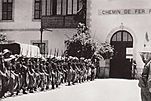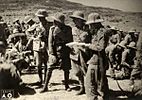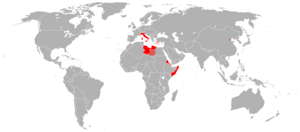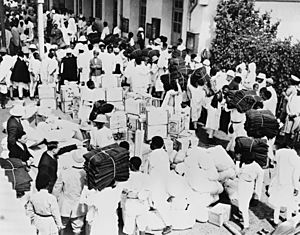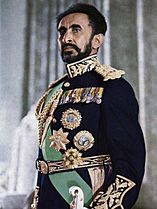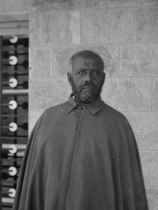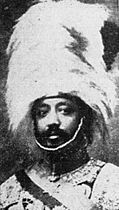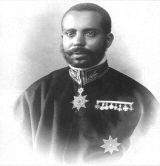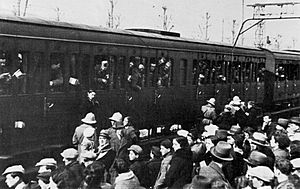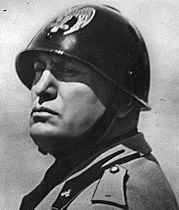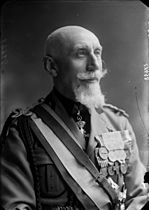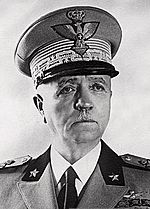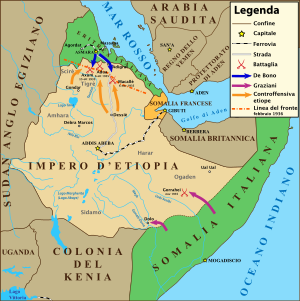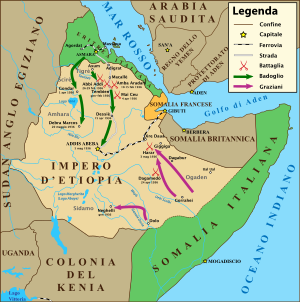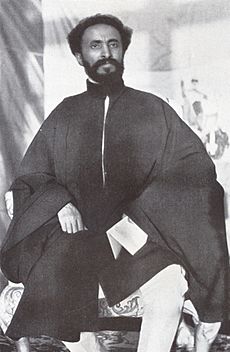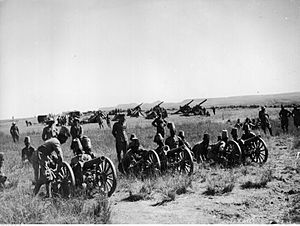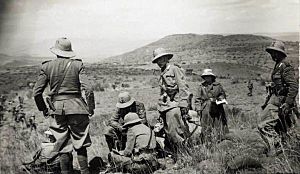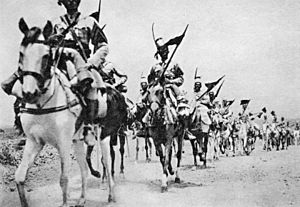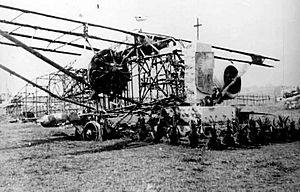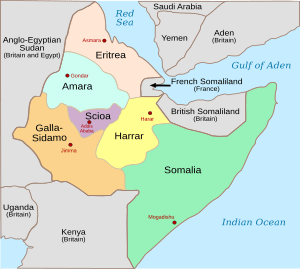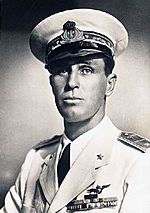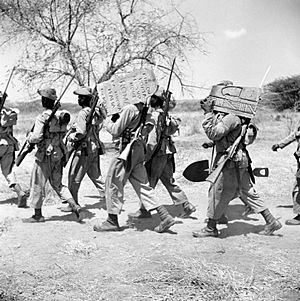Second Italo-Ethiopian War facts for kids
Quick facts for kids Second Italo-Ethiopian War |
|||||||||
|---|---|---|---|---|---|---|---|---|---|
| Part of the interwar period | |||||||||
|
|
|||||||||
|
|||||||||
| Belligerents | |||||||||
|
|
||||||||
| Commanders and leaders | |||||||||
|
|
||||||||
| Strength | |||||||||
|
|
||||||||
| Casualties and losses | |||||||||
| ~70,000 killed |
|
||||||||
|
|||||||||
| Contemporary figures of 1,148 Italian army soldiers and Blackshirts killed, 125 died of wounds, 31 missing, about 1,593 Eritrean troops killed and 453 civilian workmen killed are considered suspect. Figures of 275,000 Ethiopians killed are considered to be exaggerated. |
|||||||||
The Second Italo-Ethiopian War was a conflict between Italy and Ethiopia. It lasted from October 1935 to February 1937. In Ethiopia, people often call it the Italian Invasion. In Italy, it's known as the Ethiopian War. This war showed how some countries wanted to expand their power before World War II. It also highlighted that the League of Nations was not very effective.
On October 3, 1935, 200,000 Italian soldiers attacked Ethiopia. They were led by Marshal Emilio De Bono and came from Italian Eritrea. Another smaller group attacked from Italian Somalia. Italy did not declare war before attacking. On October 6, Italian forces captured Adwa. This place was important because Italy had lost a big battle there before. On October 15, Italian troops took Aksum. They even took an ancient obelisk from the city and sent it to Rome.
Italy's leader, Benito Mussolini, was unhappy with De Bono's slow progress. He replaced him with General Pietro Badoglio. Ethiopian forces tried to fight back in December 1935. However, their army had old weapons and no radio communication. This made it hard for them to know what the Italian army was doing. Nazi Germany secretly sent weapons to Ethiopia. This made the war last longer and used up Italian resources.
The Ethiopian counterattack stopped Italy for a few weeks. But Italy had modern weapons like heavy artillery and airplanes. They also used chemical weapons like bombs. This stopped the Ethiopians from winning more battles. Italy started its attack again in early March. On March 29, 1936, Italian forces bombed the city of Harar. Two days later, Italy won a major battle at Maychew. This ended any organized resistance from the Ethiopians.
Emperor Haile Selassie had to leave Ethiopia on May 2. Badoglio's forces entered the capital city, Addis Ababa, on May 5. Italy announced that it had taken over Ethiopia on May 7. The Italian King, Victor Emmanuel III, was declared emperor of Ethiopia. The areas of Eritrea, Italian Somaliland, and Ethiopia were combined. They formed the new Italian province of East Africa. Fighting continued until February 19, 1937. On that day, an attempt to kill General Graziani happened in Addis Ababa. This led to a terrible event called the Yekatit 12 massacre. Many civilians were killed. Italian forces continued to fight against rebels until 1939.
Italian troops used mustard gas in air attacks. This was against international rules like the Geneva Protocol. They used it against soldiers and civilians. They wanted to stop Ethiopians from supporting the resistance. There were also reports of Italian attacks on Red Cross ambulances and hospitals. Many historians believe this caused the deaths of hundreds of thousands of Ethiopian civilians. Ethiopian troops also used some forbidden weapons. These included dumdum bullets. They also killed civilian workers.
Contents
Why the War Started
East Africa's Situation
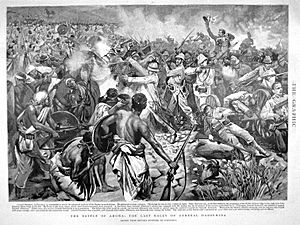
Italy started trying to create colonies in East Africa in the 1880s. Their first attempt ended badly in the First Italo-Ethiopian War. Italian forces were defeated at the Battle of Adwa in 1896. The Ethiopian Army, led by Menelik II, won that battle. After this, Italy stopped its plans to expand for a while. They only kept their small colonies of Italian Eritrea and Italian Somaliland. For many years, Italy and Ethiopia had peaceful relations.
In 1925, Italy's fascist government made a secret deal with Britain. This deal aimed to strengthen Italy's power in the region. Britain agreed that Italy had interests there. They also agreed to Italy's request to build a railway. This railway would connect Somalia and Eritrea. The plan was supposed to be a secret. But it soon became known. France and Ethiopia were very angry. Ethiopia said it was a betrayal of a country that was a member of the League of Nations.
As Italy's fascist government became more extreme, its colonial leaders pushed for more land. The governor of Italian Eritrea tried to get the Tigre people to turn against Ethiopia. The governor of Italian Somaliland started a harsh policy. This led to Italy taking over the fertile Jubaland area. It also stopped cooperation between settlers and local Somali chiefs.
The Welwel Incident
The Italo-Ethiopian Treaty of 1928 set the border between Italian Somaliland and Ethiopia. It said the border was about 118 kilometers from the coast. In 1930, Italy built a fort at the Welwel oasis. This fort was far inside Ethiopian territory. Italian officers commanded Somali troops there. On November 23, 1934, a British-Ethiopian group arrived at Welwel. They were studying grazing lands to find a clear border.
The group included Ethiopian and British experts. They had about 600 Ethiopian soldiers as guards. Both sides knew Italy had a military post at Welwel. They saw an Italian flag there. The Ethiopian government had told Italian officials about the commission. They asked for cooperation. But the Italian commander refused to let the British camp nearby.
The Ethiopian commander ignored the Italian troops and set up camp. To avoid trouble, the British left. Italian planes then flew over Welwel. The Ethiopian group stayed. For ten days, both sides threatened each other. Reinforcements arrived, making the Ethiopian group about 1,500 men. The Italians had about 500 men. On December 5, 1934, shots were fired. The Italians had an armored car and bomber planes. Machine gun fire from the car caused about 110 Ethiopian casualties. About 30 to 50 Italians and Somalis were killed. This event led to a crisis at the League of Nations. On September 4, 1935, the League of Nations said neither side was fully to blame.
Ethiopia Stands Alone
Britain and France wanted Italy as an ally against Germany. So, they did not strongly stop Italy from building up its military. Italy was sending many soldiers to its colonies in East Africa. This made Italy rely more on Germany.
In January 1935, France and Italy made an agreement. This deal gave Italy a "free hand" in Africa. In return, Italy would cooperate in Europe. In April, Italy joined the Stresa Front. This was an agreement to stop Germany from breaking the Treaty of Versailles. The first plan for this agreement talked about keeping peace everywhere. But Britain insisted it should only be about peace "in Europe." Mussolini took this as a sign that Britain would accept his invasion of Ethiopia.
In June, Britain and France had a disagreement. This was because of the Anglo-German Naval Agreement. This made it even easier for Italy. By the summer of 1935, 300,000 Italian soldiers were in East Africa. The world knew Italy was planning to invade Ethiopia. In June 1935, Anthony Eden from Britain went to Rome. He told Mussolini that Britain was against the invasion. He offered a plan for Italy to get a path through Ethiopia. This path would connect Italy's two colonies. Mussolini refused this idea. Mussolini knew about problems in the British navy. So, he thought Britain's opposition was not serious. He believed Britain would not go to war over Ethiopia.
Germany saw a chance to cause trouble between Britain and Italy. Germany sent some weapons to Ethiopia. Hitler hoped Italy would get stuck in a long war. This would make Britain put sanctions on Italy. France would likely agree to these sanctions. This would harm relations between Britain and Italy. Germany could then offer to help Italy. Hitler hoped to make Mussolini an ally. He also wanted to break up the Stresa Front.
Japan was another possible ally for Ethiopia. Some Ethiopian thinkers looked up to Japan. After the Welwel incident, some Japanese groups tried to raise money for Ethiopia. But the Japanese ambassador told Mussolini that Japan had no interest in Ethiopia. He said Japan would stay neutral. This caused anger in Japan, where people felt a connection to Ethiopia. But when Ethiopia asked Japan for help, they were refused.
Armies in the War
Ethiopian Forces
As war seemed certain, Emperor Haile Selassie ordered his army to get ready. The Ethiopian army had about 500,000 men. Some had spears and bows. Others had rifles, but many were very old. Italian estimates said Ethiopia had between 350,000 and 760,000 soldiers. Only about 25% had military training. They had 400,000 rifles of all kinds. The army had about 234 old artillery pieces. They also had some machine guns and anti-aircraft guns.
France and Britain stopped selling weapons to both sides. This hurt Ethiopia more, as it could not make its own weapons. The Ethiopian army had about 300 trucks. They also had seven armored cars and four old tanks.
The best Ethiopian soldiers were the "Kebur Zabagna" (Imperial Guard). They were well-trained and had better equipment. They wore a green-khaki uniform. Most other Ethiopian fighters wore white cotton cloaks. This made them easy targets. The skills of the Ethiopian generals varied greatly. Germany sent three planes, 10,000 rifles, and 10 million rounds of ammunition to Ethiopia.
The Ethiopian Air Force had only 13 planes and four pilots. Most of these planes were old. Some transport planes were bought for ambulance work. One racing plane was bought from England. It was supposed to carry bombs to attack Italian oil tanks. But the bombs and fuel could not reach Ethiopia in time.
About 50 foreign people joined the Ethiopian forces. These included pilots, military advisers, and doctors. Some were from France, Sweden, and other countries. The Italians later said that these foreigners helped the Ethiopians a lot.
Italian Forces
Italy had 400,000 soldiers in Eritrea and 285,000 in Italian Somaliland. They had 3,300 machine guns, 275 artillery pieces, 200 small tanks, and 205 aircraft. By April 1935, Italy had sent many more troops and supplies to East Africa. They had about 685,000 soldiers in total. They also had 6,000 machine guns, 2,000 artillery pieces, 599 tanks, and 390 aircraft. The Italian navy brought tons of supplies. The Ethiopians only had horse-drawn carts for transport.
Italy relied a lot on its colonial troops. These were soldiers recruited from Eritrea, Somalia, and Libya. The Eritrean infantry, called Ascari, were very effective. They were often used as front-line troops. Eritrea also provided cavalry and artillery units. Other colonial troops included Somali irregulars and Arab-Somali infantry.
Italy also had local allies in the north. The Azebu Galla were one group that fought for the Italians. In the south, the Somali Sultan Olol Dinle had his own army. He joined the Italians to take back lands from the Ethiopians. Italian colonial forces even included men from Yemen.
On March 28, 1935, General Emilio De Bono became the commander of all Italian forces in East Africa. He led the invasion from Eritrea in the north. General Rodolfo Graziani commanded the forces attacking from Italian Somaliland in the south. Most foreign observers and reporters were with the Italians.
The War Begins
Italian Invasion
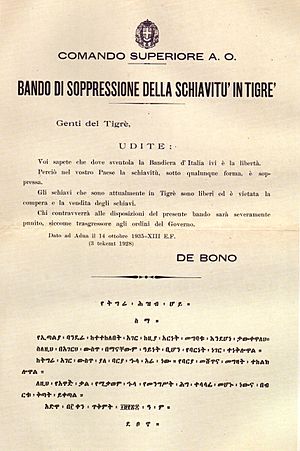
At 5:00 AM on October 3, 1935, De Bono's troops crossed the Mareb River. They entered Ethiopia from Eritrea without declaring war. Italian planes dropped leaflets. These asked Ethiopians to rebel against Haile Selassie. They wanted people to support the "true Emperor Iyasu V". Iyasu had been removed from power years earlier. In response, Ethiopia declared war on Italy.
At this time, Ethiopia's lack of roads made it hard for the Italians. On the Eritrean side, roads went right up to the border. But on the Ethiopian side, they became unclear paths. The Italian army used air photos to plan their advance. They also used mustard gas attacks.
On October 5, the Italian I Corps took Adigrat. By October 6, Adwa was captured. Haile Selassie had ordered his commanders to pull back from the border. On October 11, one commander, Gugsa, surrendered with 1,200 followers. Italy used this surrender for propaganda. But only a small part of Gugsa's men joined him. On October 14, De Bono announced the end of slavery in Ethiopia. However, this meant former slave owners no longer had to feed their former slaves. Many freed people had to ask the Italians for food.
By October 15, De Bono's forces had reached Axum. This was a holy capital. De Bono rode into the city on a white horse. He then took the Obelisk of Axum. Mussolini was unhappy with the slow advance. On November 8, Italian forces captured Makale. The Italian supply line was now longer. De Bono wanted to build a road before moving on. On November 16, De Bono was promoted. But in December, Badoglio replaced him to speed up the invasion.
Ethiopian Counterattack
Ethiopia planned a big attack in December. They wanted to split the Italian forces in the north. They also wanted to invade Eritrea. Four Ethiopian commanders led about 190,000 men. One group of 1,000 Ethiopians crossed the Tekeze river. They advanced towards a pass. The Italian commander had 1,000 Eritrean soldiers and some small tanks. When the Ethiopians attacked, the Italians fell back. But 2,000 Ethiopian soldiers were already at the pass. The Italian force was surrounded.
The Italians tried to break out with their tanks. But the rough ground stopped the vehicles. The Ethiopians killed the soldiers. Then they attacked the tanks and killed their crews. Another Italian relief group with tanks was ambushed. Ethiopians rolled rocks to stop the tanks. They killed the Eritrean soldiers and swarmed the tanks.
The Italian commander managed to escape with half his men. Italy lost 31 Italians and 370 Eritrean soldiers killed. Five Italians were taken prisoner. Ethiopia estimated their own losses at 500. News from the northern front was bad for Italy. Foreign reporters in Addis Ababa made fun of not being able to see the front. They could not check reports of many Italians being captured.
The Ethiopian plan was to divide the Italian army. Then they would crush them. After that, they would invade Eritrea. In November, the League of Nations criticized Italy's attack. They put economic sanctions on Italy. But these sanctions did not include oil. Oil was vital for modern armies. This helped Italy.
The Ethiopian attack stopped Italy for a few weeks. But Italy had better weapons like artillery and machine guns. They also used air attacks with chemical weapons, like mustard gas. This stopped the Ethiopians from winning more. The Ethiopians had very few machine guns. Most of their troops had swords and spears. Mussolini had been gathering poison gas in East Africa for ten years. He gave Badoglio permission to use gas. He was even ready to use germ warfare if it could be kept secret. Some Italians disagreed, but the practices were kept secret. The government denied them or blamed the Ethiopians.
Italy's Second Advance
As the Ethiopian attack slowed, Italy planned to attack again. Mussolini allowed the use of poison gas. Badoglio received more Italian troops in Eritrea. On January 20, Italy started its northern attack again. This was the First Battle of Tembien. Ethiopian forces were defeated. Italy used phosgene gas. Italy had 1,082 casualties. Ethiopia had 8,000 casualties, according to an intercepted message.
From February 10 to 19, Italy captured Amba Aradam. They destroyed a large Ethiopian army. The Ethiopians suffered huge losses. Poison gas destroyed part of the Ethiopian army. The Ethiopian commander and his son were killed. Italy lost 800 killed and wounded. Ethiopia lost 6,000 killed and 12,000 wounded. From February 27 to 29, two more Ethiopian armies were destroyed. Ethiopians again said poison gas was used.
In early March, another Ethiopian army was attacked and defeated. This was the Battle of Shire. In these battles, Italy lost about 2,600 soldiers. Ethiopia lost about 15,000. These Italian victories broke Ethiopia's defenses in the north. Most Ethiopian survivors went home or hid. Only the army guarding Addis Ababa remained.
On March 31, 1936, Italy defeated the main Ethiopian army. This was at the Battle of Maychew. Emperor Selassie led this army. The Ethiopians attacked the Italian defenses many times. But they could not break through. When the tired Ethiopians pulled back, Italy attacked. Italian planes attacked the survivors with mustard gas. Italy had 400 casualties. Eritrean troops had 874. Ethiopians had 8,900 casualties out of 31,000 men.
After the battle, Ethiopian soldiers started fighting like guerrillas. This was the start of the Patriot movement. Local people also joined in. As the fighting increased, Italy had to send more troops to the north. This took them away from the southern campaign.
Southern Front Battles
On October 3, 1935, General Graziani started his plan in the south. He wanted to remove Ethiopian forces from border posts. He also wanted to see how they would react to attacks. Heavy rains made it hard. But within three weeks, several Somali villages were in Italian hands. Later in the year, an Ethiopian general gathered his army. He planned to invade Italian Somaliland. Between January 12 and 16, 1936, Italy defeated the Ethiopians. This was at the Battle of Genale Doria. Italian planes destroyed the Ethiopian army. Ethiopians said poison gas was used.
After a quiet period in February 1936, Italy prepared to advance towards Harar. On March 22, Italian planes bombed Harar and Jijiga. They were almost destroyed. Harar had been declared an "open city" (meaning it should not be attacked). On April 14, Graziani attacked the last Ethiopian army. This was at the Battle of the Ogaden. The Ethiopians had a strong defensive line. After ten days, the last Ethiopian army was broken. 2,000 Italian soldiers and 5,000 Ethiopian soldiers were killed or wounded.
Addis Ababa Falls
On April 26, 1936, Badoglio began the "March of the Iron Will." This was an advance from Dessie to Addis Ababa. It was a fast move with motorized vehicles. There was little Ethiopian resistance. On May 4, Ethiopian forces attacked the column. They killed about 170 colonial troops.
Meanwhile, Selassie was retreating to the capital. Government officials were confused and could not reach the Emperor. They realized Addis Ababa would fall soon. They discussed moving the government to the west. Selassie reached the capital on April 30. His ministers decided to defend the city. Retreating would be a last resort.
The next day, Ethiopian nobles met again. They decided the Emperor should go to Geneva. He would ask the League of Nations for help. Then he would return to lead the resistance. Selassie agreed. On May 2, Selassie took a train to Djibouti. He took the gold from the Ethiopian Central Bank. From there, he fled to the United Kingdom. Mussolini had refused to bomb his train.
Before leaving, Selassie ordered the government to move. He told the mayor of Addis Ababa to keep order. Imru Haile Selassie was made Prince Regent. The police and Imperial Guard tried to control the growing crowds. But rioters looted and burned shops. Most violence was between looters. By May 5, much of the city was in ruins. At 4:00 AM, Badoglio entered the city. He had 1,600 trucks and patrols of Italian tanks and troops. The remaining people watched sadly.
Later Operations
After taking Addis Ababa, nearly half of Ethiopia was still free. Fighting continued for three more years. About 90% of the country was "pacified" before World War II. But this was kept secret from the Italian public. Ethiopian commanders regrouped in nearby areas. About 10,000 troops still resisted under Aberra Kassa. They had orders from Selassie to continue fighting. On May 10, 1936, Italian troops from the north and south met at Dire Dawa. The Italians found an Ethiopian leader who surrendered. Imru Haile Selassie went to Gore in southern Ethiopia. He planned to reorganize and keep fighting. In early June, Italy created a new constitution for Italian East Africa. It combined Ethiopia, Eritrea, and Italian Somaliland. Badoglio became the first leader. But on June 11, Marshal Graziani replaced him.
On June 21, Kassa met with other Patriot leaders. They planned to attack parts of the capital. But they lacked transport and radio equipment. This stopped a coordinated attack. In July, Ethiopian forces attacked Addis Ababa. They were defeated. Many Ethiopian royals were captured. Others were executed after surrendering. The exiled government in Gore could not lead the Patriots well. But small groups continued to resist around the capital.
On June 26, members of the Black Lions group destroyed three Italian planes in Nekemte. They killed twelve Italian officials. Graziani ordered the town to be bombed in return. Local fighting forced the Patriots out. The commander of the southern Patriots retreated. He was surrounded by Italian forces and defeated. About 4,000 Patriots were killed. This included their commander, who was killed after being captured. Other Ethiopian leaders were also executed. In late 1936, another leader was killed in battle. On December 19, Selassie surrendered at the Gojeb river.
After the rainy season, an Italian group left Addis Ababa in September. They occupied Gore a month later. The forces of Imru Haile Selassie were trapped. Imru surrendered on December 17. He was flown to Italy and imprisoned. Other Ethiopian prisoners were sent to camps. Another Italian group went south-west. They attacked other Ethiopian forces. The Ethiopians were defeated. By January, Italy controlled several provinces. After two more months, the remaining Ethiopians were surrounded. They fought instead of surrendering. Their leader was killed. On February 19, 1937, the last battle of the war happened. Ethiopian armies fought Italian forces and were defeated.
Addis Ababa Massacre
On the same day, February 19, 1937, an attempt was made to kill Marshal Graziani. This was done by Eritrean rebels in Addis Ababa. What followed was a terrible event. It is known as the worst massacre in Ethiopian history. Estimates vary on how many people were killed in the three days after the attack. Ethiopian sources say 30,000 people were killed. Italian sources claim only a few hundred. A 2017 study estimated 19,200 people were killed. This was 20% of Addis Ababa's population.
Over the next week, many Ethiopians suspected of opposing Italian rule were rounded up. They were executed. This included members of the Black Lions. Many others were imprisoned. An Italian official gave a terrible order. He told his men to "destroy and kill and do what you want to the Ethiopians" for three days. Italians poured gasoline on houses and set them on fire. They broke into homes and attacked people. The first day of the massacre is remembered as "Yekatit 12" (Ethiopian February 19). There is a monument in Addis Ababa to remember these victims.
After the War
Casualties
In 1968, Colonel A. J. Barker wrote about the Italian losses. From January 1, 1935, to May 31, 1936, the Italian army and Blackshirt units lost about 1,148 men killed. Another 125 died from wounds. About 1,593 Eritrean troops and 453 civilian workers were also killed. This was a total of 3,319 casualties. In 1978, Alberto Sbacchi said these official numbers were too low. He said the government wanted to hide the true losses.
Another estimate by Del Boca says total Italian losses up to December 31, 1936, were 4,350 Italians killed. This includes soldiers, Blackshirts, air force, navy, and civilians. About 9,000 were wounded. Another 18,200 were sent home due to illness. He estimates about 4,500 Eritrean colonial troops were killed. From 1936 to 1940, another 9,555 men were killed. And 144,000 were sick or wounded. Total Italian casualties from 1935 to 1940 were about 208,000 killed or wounded.
The Italian estimate for Ethiopian losses is 70,000 soldiers killed. This includes 50,000 in the North and 20,000 in the South. In 1946, the Ethiopian government claimed 760,300 deaths. However, Del Boca says these numbers are not reliable. He believes they were made higher to get more money for damages.
Public and World Reaction
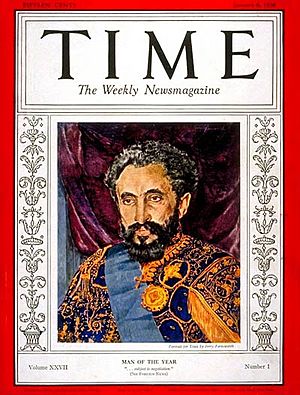
Italy's military win made people forget about economic problems. Mussolini was very popular in May 1936. He announced the Italian empire. His biographer called the war "Mussolini's masterpiece." It brought the country together behind him. When Badoglio returned to Italy, Mussolini made sure he did not get too much honor. Mussolini wanted the victory to seem like his regime's success. After the war, Mussolini created a new military rank. He made himself and King Victor Emmanuel III "First Marshal of the Italian Empire." This put him on the same level as the king.
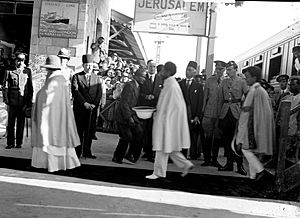
Haile Selassie left Djibouti on a British ship. From Mandatory Palestine, he sailed to Britain. While in Jerusalem, he sent a message to the League of Nations. He said they had ended a very unfair war. He chose exile so his people would not be wiped out. He asked the League to keep working for peace. He also asked them not to recognize Italy's takeover of Ethiopia.
The Emperor's message made some countries delay recognizing Italy's control. On June 30, Selassie spoke at the League of Nations. Italian journalists tried to interrupt him. They were removed. Selassie criticized Italy's actions. He also criticized the world for not helping. At the end of his speech, he said, "It is us today. It will be you tomorrow." France tried to keep Italy happy. They did not want Italy to ally with Germany. Britain felt too weak to go against France. Selassie's request to the League to deny Italy's control was rejected. He was also denied a loan to fund a resistance. On July 4, 1936, the League voted to end sanctions against Italy. By July 15, the sanctions were over.
On November 18, 1936, Japan recognized the Italian Empire. Italy recognized Japan's control over Manchuria. This ended the Stresa Front. Hitler had given weapons to Ethiopia. He hoped Italy would be weakened when he moved against Austria. Britain and France recognized Italy's control over Ethiopia in 1938. Mexico was the only country that strongly spoke against Italy's control. It respected Ethiopia's independence. In 1937, only six nations did not recognize Italy's occupation. These included China, New Zealand, the Soviet Union, Republican Spain, and the United States. Three years later, only the USSR officially recognized Selassie. The United States considered recognizing Italy's empire, including Ethiopia. The invasion of Ethiopia made Mussolini and Italy isolated until 1938. From 1936 to 1939, Mussolini and Hitler worked together. They supported the fascist side in the Spanish Civil War. In April 1939, Mussolini invaded Albania. In May, Italy and Nazi Germany formed the Pact of Steel. In September 1940, they signed the Tripartite Pact with Japan.
Italian Occupation
1936–1940
On May 10, 1936, Italian troops from the north and south met at Dire Dawa. The Italians found an Ethiopian leader who surrendered. On December 21, 1937, Rome appointed Amedeo, 3rd Duke of Aosta, as the new leader of Italian East Africa. He was told to be more friendly. Aosta started public works projects. These included 2,000 kilometers of new paved roads. He also built 25 hospitals, 14 hotels, and many other buildings. Italy made it illegal for different races to marry. They also enforced racial separation. Italians favored non-Christian groups. To weaken the Amhara rulers, who supported Selassie, Italy gave more rights to the Oromos, Somalis, and other Muslims. Many of these groups had supported the invasion. Italy also ended slavery and old feudal laws. In early 1938, a revolt started. It was led by young, educated Ethiopians. The general ordered another wave of killings. All Ethiopians in administrative jobs were murdered.
The Italian army of occupation had 150,000 men. But they were spread out. By 1941, the army grew to 250,000 soldiers. This included 75,000 Italian civilians. The former police chief of Addis Ababa, Abebe Aregai, was a very successful leader of the Ethiopian resistance. He used small groups of fifty men. On December 11, the League of Nations condemned Italy. Mussolini then left the League. The occupation was also very expensive. The budget for Italian East Africa from 1936 to 1937 was huge. It was more than Italy's yearly income. In 1939, some Ethiopian leaders surrendered to the Italian Empire. Guerrilla fighting slowly stopped. In early 1940, the last guerrilla activity was around Lake Tana.
East African Campaign, 1940–1941
While in exile, Haile Selassie tried to get support from Western countries. But he had little success until World War II began. On June 10, 1940, Mussolini declared war on France and Britain. He attacked British forces in Egypt, Sudan, Kenya, and British Somaliland. In August 1940, Italy took over British Somaliland. Britain and Selassie encouraged Ethiopians to fight against the Italians. Selassie went to Khartoum to work with the British and resistance forces. On January 18, 1941, Selassie crossed back into Ethiopia. On May 5, Selassie and an army of Ethiopian Free Forces entered Addis Ababa. After Italy's defeat, some Italian troops and their allies continued to fight. This lasted until Italy surrendered in September 1943.
Peace Treaty, 1947
The peace treaty was signed in Paris on February 10, 1947. It was between Italy and the winning powers of World War II. Italy officially recognized Ethiopia's independence. They also agreed to pay $25,000,000 for damages. The League of Nations had never officially recognized Italy's control over Ethiopia. So, Haile Selassie was recognized as the restored emperor in May 1941. Ethiopia asked for a lot of money for damages. This included the destruction of 2,000 churches and 535,000 houses. It also included the loss of millions of animals.
See also
 In Spanish: Segunda guerra italo-etíope para niños
In Spanish: Segunda guerra italo-etíope para niños
- List of Second Italo-Ethiopian War weapons of Ethiopia
- Ethiopian Air Force
- List of Second Italo-Ethiopian War weapons of Italy
- Censorship in Italy
- Faccetta Nera
- First Italo-Ethiopian War
- Paris Peace Treaties, 1947
- Timeline of the Second Italo-Ethiopian War


